|
Just how global are India's non-corporate
brands? The list we present is entirely subjective, drawn up on
the basis of the not-so-considerable wisdom of our senior editors,
and the not inconsiderable wisdom of marketing pros. To test our
hypotheses, we commissioned research agency NFO MBL India to conduct
a Global Brushstroke survey on each of the brands. The objective
was to reveal the awareness level and recall of these non-corporate
brands across randomly selected respondents across various countries.
Totally, 148 respondents from the US, the UK, Germany, Canada, Australia,
New Zealand, Malaysia, and Japan were surveyed. The results have
been presented alongside each brand. How to read them? The proportion
aware is a measure of how well-known the brand is globally. And
the associations indicate what people know them for.
 |
Goa Proportion Aware 44%
Associated with: Beaches 19%
Other Associations: Tourism, Island, Hippies, Portugese |
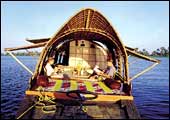 |
Kerala Proportion Aware 26%
Associated with: Tourism 30%
Other Associations: Seafood, Dosa |
GOA & KERALA
Land's End
Kerala & Goa are India's best-known holiday
brands
Goa is a bit like
the tried and tested Maruti 800: relevant but hardly different;
well-known but certainly not esteemed; low-priced and, therefore,
perhaps easily substitutable. Unlike the Maruti small car, however,
the former Portuguese colony enjoys tremendous global recall, being
more a household name in Stockholm or Copenhagen than in Surat or
Ludhiana. Thanks to the good old rupee, Goa makes for a cheap, long,
sun-kissed, lager-filled vacation. Reports indicate that Kashmir,
Pakistan and Godhra notwithstanding, chock-full charter flights
are readying to touchdown on Goan soil come September. Even in 2001
(as bad a year as they came), Goa managed to attract 2.6 lakh international
toursits and earn around Rs 1,000 crore in revenues from tourism.
Goa, as it is today, doesn't need much selling. What it needs is
some efforts at making it more esteemed.
Kerala gets just about as many tourists as
Goa and accounts for less than 3 per cent of the Rs 22,000 crore
South Asia earns from in-bound tourism. But it has, arguably, a
far more vibrant brand. "Kerala has taken the destination aspect
of a travel brand and converted it into an unparalleled brand experience,"
says R. Sridhar, ceo brand.comm, a brand consultancy. Price is very
much a part of the equation, but not all of it as it almost invariably
is in Goa's case. The global Kerala brand may be younger than its
Goan counterpart, but it is likely to be far more resilient.
Brian Carvalho & Shailesh
Dobhal
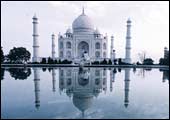 |
Proportion Aware 96%
Associated with: Monument 44%
Other Associations: Beautiful Place, Wonder of the World |
THE TAJ MAHAL
Grand Tomb
Ries and Trout couldn't have given the Taj Mahal
a better history.
As many foreign
toursists visited the Taj in 2001 as did the entire states of Goa
and Kerala. "Globally, the Taj's recognition is virtually 100
per cent," says B. Narayanaswamy, Executive Director, Indica
Research. From tea to hotels to casinos to a relatively obscure
blues musician, everything and everyone has borrowed the Taj name
to great effect. The lure of the brand is understandable: with its
association with perfection and wild romanticism the Taj marries
the physical and the ephemeral to great commercial effect.
It cost Rs 3.2 crore (in 17th century prices)
to build the Taj. The monument-one of the seven wonders of the world-earned
the Indian exchequer Rs 12.4 crore last year through entry fees,
with 75 per cent coming of that from foreign visitors. In terms
of what it does to the city of Agra, though, the Taj's simply priceless.
-Shailesh Dobhal
 |
Proportion Aware 16%
Associated with: Musician50% |
A.R. RAHMAN
World Music
Bombay Dreams could catapult Rahman onto
the world stage.
The numbers tell
the story of Alla Rakha Rahman's standing in India: 107 million
albums sold. International recognition has been nudging him for
some time. With Andrew Lloyd Webber's Bombay Dreams, though, Rahman
may have arrived. Miramax is taking the show to New York, and the
buzz in Chennai (Rahman's base) is that he has signed on for a couple
of Broadway musicals. The man himself is busy working on one of
the five films he does every year, Rajnikant's Baba. And theatres
issuing tokens that people can turn in for the cassettes and CDs
when they are released are seeing serpentine queues.
-Nitya Varadarajan
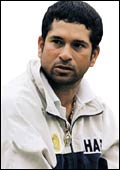 |
Proportion Aware 14%
Associated with: Cricketer 62% |
SACHIN TENDULKAR
Sporting Star
His appeal may be restricted, but that could
change soon.
A Google search
on Sachin Tendulkar returns roughly a tenth of what one on Michael
Schumacher does but, "Sachin," says his handler, WorldTel
CEO Samir Singh, "is bigger than all sporting legends you can
name in terms of the intensity with which people follow his game."
"Why," he adds, "so many Americans associate India
as the land of Sachin." Spoken like a true agent. But Singh
does believe what he says: WorldTel is tying up the loose ends involved
in the launch, in the US and in the entire Commonwealth family,
of a Sachin range of branded sportswear (including shoes). If that
works, the Sachin brand, valued at close to Rs 1,200 crore in India
by some estimates, could go truly global. The International Cricket
Council claims cricket is now played in 154 countries. Imagine what
would happen if people in even a third of that number started seriously
following the game. Schumi, Beckham, here comes Ten-dul-karrrrrrrrrrrrrrrrrrr.
-Shailesh Dobhal
 |
Proportion Aware 9%
Associated with: Chess 25% |
VISWANATHAN ANAND
Intellectual Appeal
Chess' universality could make Viswanathan
Anand the best-known Indian sportsperson, ever.
Cricket has fanatic
followers in ten, maybe fifteen countries. Chess has a smaller,
but more rabid following in 150. In terms of sheer width of appeal,
Viswanathan Anand's reach could make Sachin Tendulkar look like
the immensely talented cricketer who lives down the road. The lightning
kid's age-he is in his early thirties-and temperament helps. Not
since Bobby Fischer has the chess firmament boasted a personality
like him-and Fischer was cranky. "What really stands out about
Anand," says Kuruvilla Abraham of Chennai-based TNG Sponsorship
India which represents Anand (fine, he's paid to say nice things),
"is that he is a humorous, friendly, approachable person, completely
untouched by his fame and celebrity status". For the record,
he may also be one of the three people of note (Newscorp's Rupert
Murdoch and Reliance's Mukesh Ambani being the other two) to have
appeared on Simi Garewal's chat show on Star World.
It's hard to put a value to the Anand brand.
He doesn't do too many endorsements (he did one for NIIT and that
fetched him a reported Rs 5 crore) and his net worth is estimated
to be Rs 96 crore, as compared to, say, Michael Schumacher's career
earnings of $197 million (Rs 965 crore).
Then, how do you value the intangibles: like
the fact that the Spanish Prime Minister-Anand lives in Collano
Mediano, Spain, see-once named him among the 40 most important people
in Spain. Still want to argue about his brand status?
-Subhajit Banerjee
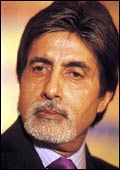 |
Proportion Aware 17%
Associated with: Actor 85% |
AMITABH BACHCHAN
Star Value
At 60, Amitabh Bachchan is probably the most
global of Indian actors.
Aamir Khan may
have a problem with that most-global tag: after all, wasn't Lagaan
nominated for the Oscars? So too will Kollywood maharajah Rajnikant
who has a huge fan following in Japan. Neither has a wax likeness
at Madame Tussauds. And neither figured in a BBC News Online poll
on the greatest star of stage and screen of the previous millennium:
Bachchan topped it and despite the people who clocked in at #5 (Homer
Simpson) and #10 (Govinda), it is an achievement.
There's no debating the man's status as Indian
entertainment's #1 brand: he is reported to earn a cool Rs 3 crore
a film and film-industry pundits put the value of his brand at close
to Rs 200 crore. "No one commands the same recognition as him,"
gushes Taran Adarsh, Editor, Trade Guide, a Mumbai-based film-industry
journal.
That's in India where Bachchan reigns large
as corporate India's preferred endorser and celeb-model rolled into
one. Globally, there's little, apart from the waxwork and the results
of the BBC Poll to show. That could change; Bachchan has expressed
an interest to work in Hollywood. "He can be a lot more powerful
(as a brand) nationally and internationally," says Jagdeep
Kapoor who runs brand consultancy Samsika out of Mumbai. We'll wait
-Abha Bakaya
 |
Proportion Aware 50%
Associated with: Indian Film Industry 32%
Other Associations: Hollywood in India, largest film
producing centre |
BOLLYWOOD
B wants to be H
Circa 2002, Bollywood is set to make inroads
into the global film biz. Will it?
In 1999 auteur
Mani Ratnam's Dil Se became the first Indian motion pic to break
into the UK Top Ten. Three others followed, Taal, Hum Dil De Chuke
Sanam, and K3G (the last grossed $1 million in its opening weekend
in the US and entered the US Top Ten). Baz Luhrman was inspired
enough by Bollywood to adapt a song from the Magnificent-Sevenesque
China Gate for Moulin Rouge. Then Lagaan, Monsoon Wedding (one of
the ten highest earning foreign pics in the US), Devdas, and Bombay
Dreams happened. And a brand that accounts of sales of a not inconsiderable
$100 million in the US-purely from DVD sales, rentals, pay TV, and
live shows-had arrived. The big worry is that Occidental interest
in this typically Asian sight-and-sound spectacle is but a passing
fancy. "Bollywood's appeal," says Komal Nahata, Editor,
Film Information, a Mumbai-based trade journal, "is restricted
to Indians and Asian abroad." "But it has potential."
That it does and Egypt, declares Kiran Khalap, founder of brand
consulting firm Chlorophyll, offers a glimpse of the possible. "People
spend their entire disposable income on Hindi films." There
are the usual problems, of course: of identity-is Bollywood just
about three hour song-and-dance fiestas-and of professionalism.
"We need to be more professional in our approach," admits
actor and director Anupam Kher. "Just having money doesn't
work anymore." Part of that professionalism will have to be
expended on the sourcing of funds: the underworld's connection to
Bollywood financiers is fairly well-known but rarerly documented.
Despite all this, the $3.5-billion industry-the global film industry
is worth a staggering $300 billion-is among the most global Indian
brands.
-Abha Bakaya
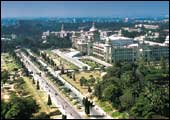 |
Proportion Aware 50%
Associated with: IT/Silicon Valley 27% |
BANGALORE
Soft Appeal
Technology has given Bangalore a brand cadence
all its own.
Rs 9,000 crore
in software exports. Visits, in the past 24 months, from British
Prime Minister Tony Blair, Chinese Premier Zhu Rongji and Communist
Party strongman Li Peng, German Chancellor Gerhard Schroder, and
Singapore Prime Minister Goh Chok Tong. ''Delhi is the political
capital of India and Mumbai may be its commercial capital,'' says
Vivek Kulkarni, it Secretary to the Government of Karnataka, ''but
Bangalore is the infotech capital, a symbol of the country's new
economy prowess.''
Bangalore is also, arguably, India's best known
business brand. ''Whenever there is talk of technology, specifically,
software, India, and increasingly, Bangalore's name automatically
pops up,'' explains V. Ravichander, CEO, Feedback Consulting, a
city-based research and consulting firm. He isn't exaggerating the
case: Wired magazine gave the city the Boomgalore monicker, and
Newsweek ranked it among the top 10 tech cities around the world.
Part of Bangalore's brand equity comes from
the companies located there. Every tech MNC worth its name has a
presence in the city. And Infosys and Wipro are not unknown in international
corporate circles. ''Bangalore is a recognised name internationally,''
says Infosys ceo Nandan Nilekani. And the local government proudly
claims that Bangalore is Asia's fastest-growing city; its population
has increased 600 per cent over the past 40 years. Boomgalore it
is.
-Venkatesha Babu
 |
Proportion Aware 91%
Associated with: Meditation 56%
Other Associations: Mind Control |
YOGA
Extension Brand
Yoga may be the most global Indian brand of
them all.
You can't get
any more global than the cover of Time magazine. And you can't any
more marquee than Julia Roberts, Madonna, Sting, Angelina Jolie,
and Jane Fonda (all die-hard yoga enthusiasts). Almost 15 million
Americans include some form of yoga in their exercise regimen, and
a $70-million yoga merchandise industry has mushroomed. Anyone for
prana pants? It isn't just the US: from Gibraltar to Belize and
Israel to Luxembourg, yoga schools and centres can be found all
over the world. There are 180 Iyengar yoga schools around the world.
Sivananda Ashram boasts a 250-acre facility near Montreal. And Kripalu
Center runs the US' largest yoga school. It'll take some contortion
for any other brand to emulate that.
-Vinod Mahanta
GURUS
Brands of God
Gurus have shaped the India-view of many global
free spirits.
 |
 |
 |
Proportion Aware
25%
Associated with: Meditation 37% |
Proportion Aware
7%
Associated with: Ashram 37% |
Proportion Aware
19%
Associated with: Spiritual leader 37% |
Spirituality sells.
Just ask Satya Sai Baba, Sri Sri Ravi Shankar, Maharishi Mahesh
Yogi, Osho, Swami Chinmayananda, and Srila Prabhupada (he who founded
ISKCON, the International Society of Krishna Consciousness). Each
has built a multinational corporation that is the envy of lesser
corporates. Ravi Shankar's Art of Living foundation has a presence
in 135 countries. The Puttaparthi Godman has 1,200 Sai Baba centres
in 137 countries. And ISKCON boasts 300 temples, 40 rural communities,
26 schools, and 40 restaurants in 71 countries. That's as global
as they get. "Indian gurus are distinctive brands. In an area
of generic offering, many have been able to carve out distinctive
territories. They offer virtually trademarked 'paths' to salvation,"
says Alok Nanda, CEO, Alok Nanda Communications, a Brand Consultancy.
It's hard to put a value to the empires of
these godmen (Sai Baba's is valued at Rs 2,500 crore; Ravi Shankar's
at Rs 500 crore). It's harder to estimate their brand value: who's
to assess God? The new millennium has brought with it a rising tide
of disillusionment among erstwhile believers. That has translated
into lawsuits against several gurus, but what the heck, even the
Catholic Church is under threat.
-Vinod Mahanta
|

